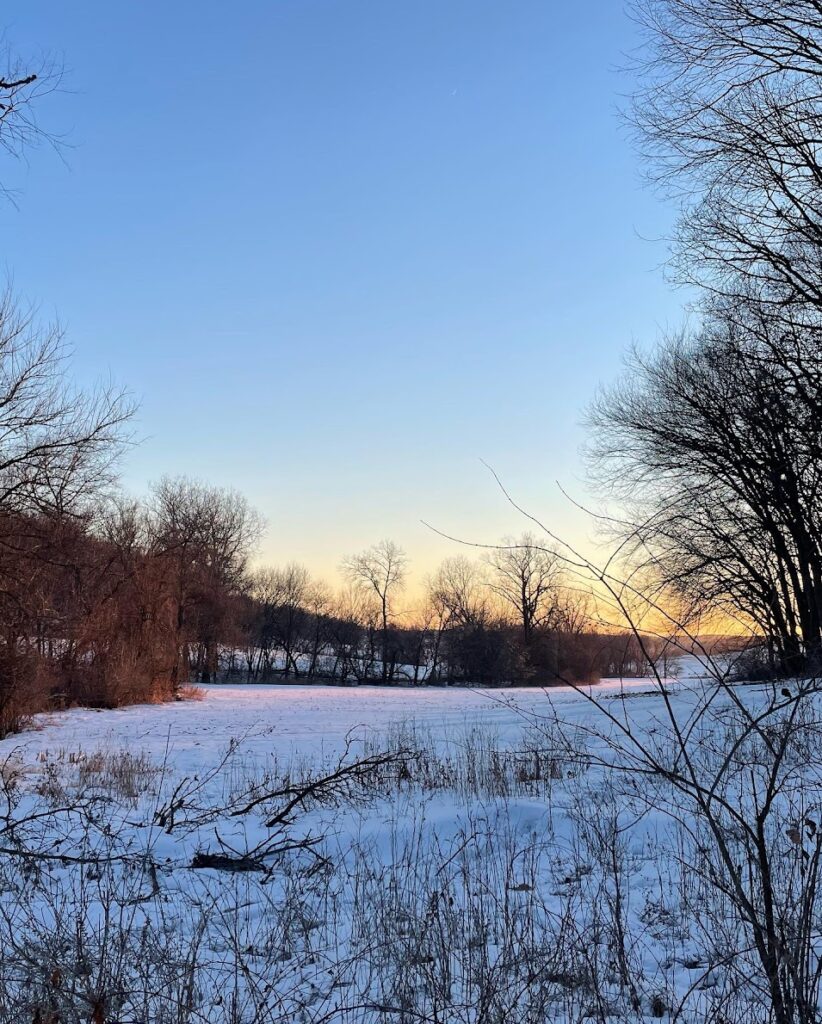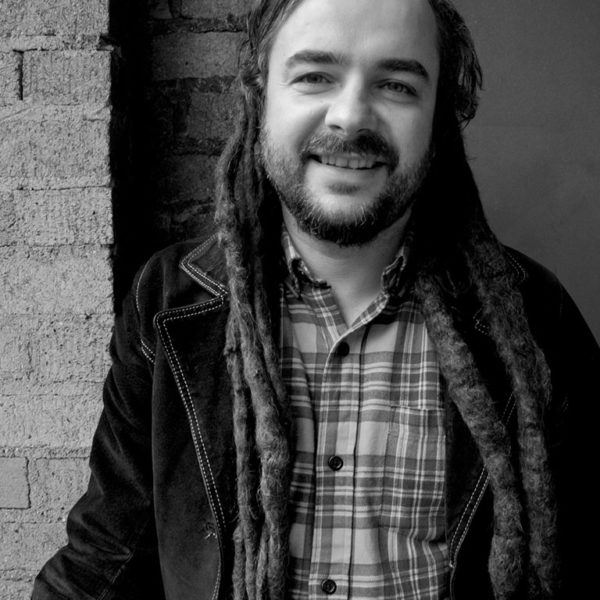Little Winter Flower
Soon after I turned 24 last winter, I went on a weekend hermitage. I stayed in a solitary cabin in rural Illinois, remote and full of bare trees, ice, quick, glittery sunsets and freezing temps at a retreat center, run by the Sisters of St. Joseph.
My first day there, I spent a long afternoon writing in my journal — chaotic, anxious thoughts about my new age, my stage and calling in life and place in the world, trying to make sense of it all. I was wanting to unravel a creeping uncertainty of my own love for God, wondering if I’m being truly authentic like I desire to be, realizing how insufficient and papery the identities I make for myself really are.
As I was frantically processing all of this, I felt something in me say, hey, look up! You are missing out on the meadows and cold piercing sky. Look at the dried grasses poking through the snow like their own seedy symphony. Go breathe the open air of farmlands and freshness.

Seeing the snow fall in the late afternoon light made me think of St. Therese of Lisieux and how she describes her vow ceremony in her autobiography, “Story of a Soul.” “Nothing was missing, not even snow. Have I told you, dear Mother, of how much I love snow? … I wonder how I got this liking for snow. Perhaps because I was a little winter flower and the first thing I saw was the earth adorned with a mantle of white. So, on the day I received the habit, I longed to see the world dressed in white like me. But on the day before it was as mild as spring and I gave up all hope of snow … Then, turning towards the quadrangle, I saw it was completely covered with snow! How considerate of Jesus! He sent the snow to satisfy the longing of His little bride. Could any man, however powerful, make a single snowflake fall to please his beloved?”
I then wrote in my journal: And now it’s snowing! Like Therese I am your winter flower … thank you my God. I love you. I went outside and dug my short fingernails into the pebbly ice-snow and ate it, that crunchy snow that tastes like sky and oxygen with an aftertaste of stale sun.
St. Therese, beloved to so many, is my patron saint. All I really knew about her when I chose her as my saint during confirmation (like many 14-year-old Catholic girls do) is that she loved flowers, and her name, “Little Flower,” made me happy. It was only two years ago, in the fall of 2020, that I read “Story of a Soul” for the first time. I am grateful for Therese’s patience and persistence in making her way to me. I needed to read “Story of a Soul” exactly when I did — 22 going on 23 (which is how old Therese was when she wrote the words in it), when I was in an overwhelming, fragile, confusing time of life. They were trustworthy, anchoring words of truth and goodness while I was living in Washington D.C. and constantly absorbing devastating news cycles, unjust societal powers and personal pain.
Those moments of reading “Story of a Soul,” slowly chewing on each word, making pencil markings in the margins, cuddling under a blanket in the safety of a lamp-lit room, are precious to me. Therese was and is a companion. I continue to feel seen and loved by her — in all my truthfulness and sorrow — in a way that’s hard to explain.
“I have reached a stage in my life,” Therese writes, near the beginning of her book, “when I can glance back at the past, for my soul has matured in a crucible of inner and external trials. Now, like a flower braced by a storm, I can raise my head and see that the words of the Psalmist have been fulfilled in me: ‘The Lord is my shepherd, how can I lack anything?’”
Therese was born in 1873. All four of her older sisters became nuns, and she knew from a young age that she wanted to become a Carmelite. She was so convicted of this that when the Carmelite community said she was too young, she went all the way to Rome, to the Pope, to be granted his permission to enter religious life at age 15.
To behold a winter flower is an intercession all its own to the saint who believed all Jesus wants for us is happiness and love.
What I love about Therese, in addition to her Little Way and pursuit of holiness in the everydayness of life, is her unashamed boldness in her love for Jesus and knowing so deep in her bones what her calling and vocation is. She writes to Jesus: “Perhaps I am being presumptuous … no, of course not … for a long time You have let me be bold and free with you.”
She has a deep mystical knowledge of her vocation and love of Christ that is beyond words, and she has the audacity to follow it, for being with Jesus is the only way she could live. “Oh, how sweet the first kiss of Jesus was! It was a kiss of love,” she writes. “Jesus made no demand on me; He asked for no sacrifices. For a long time Jesus and little Therese gazed at each other and they understood each other. On that day it was no longer a matter of gazing: it was a union. There were no longer two of us. Therese had disappeared like a drop of water lost in the depth of the ocean.”
This love she speaks of — this primordial, simple, real love of Christ — is within us, always. “I know that the kingdom of God is within us,” Therese writes. “Jesus has no need of books or doctors of the Church to guide souls. He, the Doctor of doctors, can teach without words. I have never heard Him speak, but I know that He is within me. He guides and inspires me every moment of the day.”

The last night of my hermitage, the stars lulled me awake to go see them. I have never before felt the absolute, total, utter stillness of that night — not even a tiny rustle of wind, nothing disturbing the bare trees reaching up into the sharp, intimidating, fully-alive clarity of a rural winter sky. It felt as though the stars sang — in their studded-with-everything-true silence — of God, and I was drawn inexplicably out of bed and to it. I longed to join in to that silent cutting song, my body full of the humming energy of being alive that I cannot help.
Standing in the winter snow, I felt what Therese meant when she wrote that “Love has so worked within me that it has transformed my soul into itself.” Being in solitude reminded me of what is true — my joyous longing for God who lives and loves within me. I so often make it complicated, but the moments when I feel I’m truly in my body, I realize again how simple that truth is.
Therese died at age 24 from tuberculosis. Whenever I see winter flowers, dripping with ice or frosted with snow pebbles, I’m reminded of her. To behold a winter flower is an intercession all its own to the saint who believed all Jesus wants for us is happiness and his love.

I look forward to the first snowfall of the season. I will smile with Therese, and Jesus, her love, who makes snowflakes fall for the ones he calls beloved.
ABOUT THE AUTHOR

Cassidy Klein is an essayist, journalist and creative writer based in Chicago, Illinois. She grew up in Denver, Colorado, and attended Point Loma Nazarene University in San Diego, California, to study journalism and philosophy. After college Cassidy moved to Washington, D.C. for a fellowship with Sojourners Magazine, where she worked as an editorial assistant. Now in Chicago, she lives at The Fireplace, a community of artists, activists and Catholic sisters. She is a freelance writer, editor and assistant with adults with intellectual disabilities at L’Arche Chicago. Find more of her work at cassidyrklein.weebly.com.





